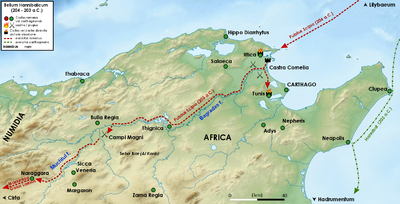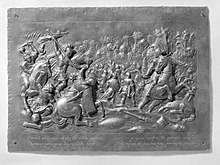Battle of Utica (203 BC)
In the wake of its defeat in the First Punic War (264–241 BC) Carthage expanded its territory in south-east Iberia (modern Spain and Portugal).
The Romans were outnumbered and so avoided battle; the Carthaginians were wary of Scipio's skill as a field commander and content to wait for reinforcements.
[3] The war lasted for 23 years, from 264 to 241 BC, and was fought primarily on the Mediterranean island of Sicily, its surrounding waters and in North Africa.
[3] The Carthaginians were defeated[4][5] and by the terms of the Treaty of Lutatius evacuated Sicily and paid Rome an indemnity of 3,200 silver talents[note 1] over ten years.
[8] Four years later, Rome seized Sardinia and Corsica on a cynical pretence and imposed a further 1,200 talent indemnity,[note 2][9][10] actions which fuelled Carthaginian resentment.
[11][12] The near-contemporary historian Polybius considered this act of bad faith by the Romans to be the single greatest cause of war with Carthage breaking out again nineteen years later.
[16] In 219 BC Hannibal, the de facto ruler of Carthaginian Iberia, led an army to Saguntum and besieged, captured and sacked it.
[19] Hannibal led a large Carthaginian army from Iberia, through Gaul, over the Alps and invaded mainland Italy in 218 BC.
[21] The historian Toni Ñaco del Hoyo describes these as "great military calamities",[20] and Brian Carey writes that they brought Rome to the brink of collapse.
In 211 BC the Romans suffered a severe reverse at the battle of the Upper Baetis and were penned back by the Carthaginians to the north-east corner of Iberia.
[27][28] Most male Roman citizens were liable for military service and would serve as infantry, with a better-off minority providing a cavalry component.
Approximately 1,200 of the infantry – poorer or younger men unable to afford the armour and equipment of a standard legionary – served as javelin-armed skirmishers known as velites; they each carried several javelins, which would be thrown from a distance, a short sword and a 90-centimetre (3 ft) shield.
It was the long-standing Roman procedure to elect two men each year as senior magistrates, known as consuls, who in time of war would each lead an army.
[46] He was denied the triumph he would normally have expected on the grounds that he had not occupied any of the magistracies of the cursus honorum, the sequential mixture of military and political administrative positions held by aspiring Roman politicians.
Hannibal was still on Italian soil; there was the possibility of further Carthaginian invasions,[50] shortly to be realised when Mago Barca landed in Liguria;[51] the practical difficulties of an amphibious invasion and its logistical follow up were considerable; and when the Romans had invaded North Africa in 256 BC during the First Punic War they had been driven out with heavy losses, which had re-energised the Carthaginians.
[52] Eventually a compromise was agreed: Scipio was given Sicily as his consular province,[53] which was the best location for the Romans to launch an invasion of the Carthaginian homeland from and then logistically support it, and permission to cross to Africa on his own judgement.
[30][35] With up to half of the complement of his legions being fresh volunteers, and with no fighting having taken place on Sicily for the past five years, Scipio instigated a rigorous training regime.
[56] Also during 205 BC, 30 Roman ships under Scipio's second-in-command, the legate Gaius Laelius, raided North Africa around Hippo Regius, gathering large quantities of loot and many captives.
[60] The locals fled and Carthage's immediate response, a scouting party of 500 cavalry, was defeated with the loss of its commander and the general in overall charge of responding to the invasion.
Following a stratagem agreed with Scipio, Masinissa's cavalry raided Hanno's force who chased them off and then pursued them into a Roman ambush.
[71] Scipio drew out the negotiations with Syphax, eventually stating he was in broad agreement with the proposition, but that his senior officers were not yet convinced.
[74] Scipio was acting in bad faith, as he had no intention of agreeing a peace treaty and the only purpose of the talks from his point of view was to gain militarily useful intelligence.
[72][76] In 203 BC, as the better weather of spring approached, Scipio made an announcement to his troops that he would shortly attempt to storm the defences of Utica and began obvious preparations to do so.
[74][78] Thanks to the careful prior reconnoitring both forces reached the positions from which they were to start their attacks without problems, despite the inherent difficulty of night manoeuvres.
Laelius's column attacked first, storming the camp of Syphax's Numidians and concentrating on setting fire to as many of the reed huts as possible.
The camp dissolved into chaos, many of its Numidian occupants oblivious of the Roman attack and thinking the barracks had caught fire accidentally; some were burned to death and others were trampled in the panic.
Ancient sources claim that either 30,000 or 40,000 Carthaginians and Numidians were killed and either 2,400 or 5,000 captured; modern historians consider these to be greatly exaggerated.
[82] With no Carthaginian field army to threaten them, the Romans pressed their siege of Utica and pillaged an extensive area of North Africa with strong and far-ranging raids.
[86] The Roman Senate ratified a draft treaty, but because of mistrust and a surge in confidence when Hannibal arrived from Italy, Carthage repudiated it.
[87] Hannibal was placed in command of another army, formed of his and Mago's veterans from Italy and newly raised troops from Africa, with 80 war elephants but few cavalry.



